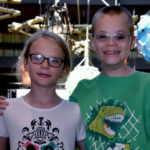All eyes on retinoblastoma: How Lyla and her mom are helping change lives

Meghan Landry firmly believes that art saved her daughter Lyla’s life. Now, she hopes to leverage the power of creativity to help support other kids like Lyla, who was diagnosed with retinoblastoma at 18 months old.
Meghan, who lived in Florida at the time, was waiting with Lyla for a routine pediatrician appointment when she noticed a small poster warning parents about the signs of retinoblastoma, including an unusual glow around the eye in flash photographs. When she asked Lyla’s doctor about the poster, he reassured her that retinoblastoma — a type of childhood eye cancer — is very rare.
Several months later, Meghan and Lyla had moved to Massachusetts. It was the middle of the COVID-19 pandemic, Lyla’s father had passed away unexpectedly, and Meghan was coping with the challenges of being a single parent. Flipping through some recent photos of Lyla, she noticed a strange yellow-gold ring around her right eye.
“I couldn’t have told you what I ate for lunch the day before, but I remembered that poster like it was yesterday,” she says. She called Lyla’s new pediatrician.

A difficult journey
Almost immediately, her pediatrician referred her to Dr. Efren Gonzalez, director of the Ocular Oncology Center at Boston Children’s Hospital. Lyla underwent testing, including an MRI scan, which revealed that she did have retinoblastoma in her eye — not just one tumor, but nearly 30 of them.
Because of Lyla’s advanced disease, Dr. Gonzalez recommended enucleation, or the removal of Lyla’s affected eye, rather than have her undergo chemotherapy. Since then, she has been cancer free and returns to Boston Children’s for regular vision exams and checkups. Now 4, she’s also adjusting to her prosthetic eye. The journey hasn’t always been easy: “I was super depressed at first and felt really alone,” admits Meghan. “I spent a lot of time just Googling and began to meet other families who felt the same way.”
Positivity from grief
Ultimately, Meghan realized she wanted to do something to help other kids and families. “I wanted to turn my grief into something positive,” she says. Remembering the impact of that simple poster at her doctor’s office, she began to brainstorm. For inspiration, she didn’t need to look further than her own daughter.
“Prosthetic eyes combine medicine, science, and artistry,” she says. Yet they aren’t always covered by insurance and are expensive to replace, often costing between $2,500 to $8,000. What’s more, retinoblastoma can be life threatening if not caught and treated early. With the goals of raising awareness, offering support, and providing financial relief to families, Art for Eyes was born. The nonprofit aims to raise awareness — and funds — by sharing and selling art through galleries and events. There’s one caveat: All of the art must feature eyes.

Changing lives through art
Art plays another important role in Meghan’s life. Lyla, who also has autism, is nonverbal, and she and her mom rely on storyboards and pictures to communicate — a practice that has led to a new hobby. “She’s a sensory seeker and especially loves textures — whatever she can stick her hands in,” says Meghan. These days, that includes paint, which Lyla loves to spread on surfaces from canvas to rocks.
While it’s too early to say whether Lyla will someday become one of the artists whose work benefits Art for Eyes, her experience with retinoblastoma has already helped change lives.
“Once you have community as a parent of a child with a serious condition, you feel less alone,” says Meghan. “We don’t want to be pitied. We want to be purposeful.”
Make an appointment with the Ocular Oncology Center.
Related Posts :
-

After retinoblastoma, Finn 'keeps on showing us what he can do'
Six-year-old Finn Carlson “isn’t afraid of anything,” says his mother, Shannon. Whether he’s playing with firetrucks, chasing after ...
-

All together: Siblings both overcome retinoblastoma
In some ways, PJ and Jovi Fisher couldn’t be more different. PJ, 9, is quiet, laidback, and loves playing Minecraft ...
-

Newborn genetic screening for pediatric cancer risk could save lives
Numerous genetic mutations increase children’s risk for various cancers. When they are detected early, cancers can potentially be caught ...
-

Which genetic syndromes can increase a child’s risk of cancer?
Inherited cancers account for at least 5 to 10 percent of all pediatric cancers. The same advances in technology that have enabled ...





